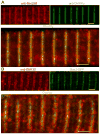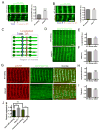Transport of the alpha subunit of the voltage gated L-type calcium channel through the sarcoplasmic reticulum occurs prior to localization to triads and requires the beta subunit but not Stac3 in skeletal muscles
- PMID: 28697281
- PMCID: PMC5569907
- DOI: 10.1111/tra.12502
Transport of the alpha subunit of the voltage gated L-type calcium channel through the sarcoplasmic reticulum occurs prior to localization to triads and requires the beta subunit but not Stac3 in skeletal muscles
Abstract
Contraction of skeletal muscle is initiated by excitation-contraction (EC) coupling during which membrane voltage is transduced to intracellular Ca2+ release. EC coupling requires L-type voltage gated Ca2+ channels (the dihydropyridine receptor or DHPR) located at triads, which are junctions between the transverse (T) tubule and sarcoplasmic reticulum (SR) membranes, that sense membrane depolarization in the T tubule membrane. Reduced EC coupling is associated with ageing, and disruptions of EC coupling result in congenital myopathies for which there are few therapies. The precise localization of DHPRs to triads is critical for EC coupling, yet trafficking of the DHPR to triads is not well understood. Using dynamic imaging of zebrafish muscle fibers, we find that DHPR is transported along the longitudinal SR in a microtubule-independent mechanism. Furthermore, transport of DHPR in the SR membrane is differentially affected in null mutants of Stac3 or DHPRβ, two essential components of EC coupling. These findings reveal previously unappreciated features of DHPR motility within the SR prior to assembly at triads.
Keywords: DHPR; EC coupling; Stac3; calcium channel; skeletal muscle; trafficking; zebrafish.
© 2017 John Wiley & Sons A/S. Published by John Wiley & Sons Ltd.
Conflict of interest statement
Competing interests
The authors have no competing interests associated with the research reported in this study.
Figures







Similar articles
-
STAC3 incorporation into skeletal muscle triads occurs independent of the dihydropyridine receptor.J Cell Physiol. 2018 Dec;233(12):9045-9051. doi: 10.1002/jcp.26767. Epub 2018 Aug 2. J Cell Physiol. 2018. PMID: 30071129 Free PMC article.
-
Congenital myopathy results from misregulation of a muscle Ca2+ channel by mutant Stac3.Proc Natl Acad Sci U S A. 2017 Jan 10;114(2):E228-E236. doi: 10.1073/pnas.1619238114. Epub 2016 Dec 21. Proc Natl Acad Sci U S A. 2017. PMID: 28003463 Free PMC article.
-
The distal C terminus of the dihydropyridine receptor β1a subunit is essential for tetrad formation in skeletal muscle.Proc Natl Acad Sci U S A. 2022 May 10;119(19):e2201136119. doi: 10.1073/pnas.2201136119. Epub 2022 May 4. Proc Natl Acad Sci U S A. 2022. PMID: 35507876 Free PMC article.
-
Organization of junctional sarcoplasmic reticulum proteins in skeletal muscle fibers.J Muscle Res Cell Motil. 2015 Dec;36(6):501-15. doi: 10.1007/s10974-015-9421-5. Epub 2015 Sep 15. J Muscle Res Cell Motil. 2015. PMID: 26374336 Review.
-
Bridging the myoplasmic gap II: more recent advances in skeletal muscle excitation-contraction coupling.J Exp Biol. 2016 Jan;219(Pt 2):175-82. doi: 10.1242/jeb.124123. J Exp Biol. 2016. PMID: 26792328 Review.
Cited by
-
STAC3 incorporation into skeletal muscle triads occurs independent of the dihydropyridine receptor.J Cell Physiol. 2018 Dec;233(12):9045-9051. doi: 10.1002/jcp.26767. Epub 2018 Aug 2. J Cell Physiol. 2018. PMID: 30071129 Free PMC article.
-
Duplex signaling by CaM and Stac3 enhances CaV1.1 function and provides insights into congenital myopathy.J Gen Physiol. 2018 Aug 6;150(8):1145-1161. doi: 10.1085/jgp.201812005. Epub 2018 Jun 27. J Gen Physiol. 2018. PMID: 29950399 Free PMC article.
-
Stac proteins associate with the critical domain for excitation-contraction coupling in the II-III loop of CaV1.1.J Gen Physiol. 2018 Apr 2;150(4):613-624. doi: 10.1085/jgp.201711917. Epub 2018 Feb 21. J Gen Physiol. 2018. PMID: 29467163 Free PMC article.
-
Stac protein regulates release of neuropeptides.Proc Natl Acad Sci U S A. 2020 Nov 24;117(47):29914-29924. doi: 10.1073/pnas.2009224117. Epub 2020 Nov 9. Proc Natl Acad Sci U S A. 2020. PMID: 33168737 Free PMC article.
-
Allosteric regulators selectively prevent Ca2+-feedback of CaV and NaV channels.Elife. 2018 Sep 10;7:e35222. doi: 10.7554/eLife.35222. Elife. 2018. PMID: 30198845 Free PMC article.
References
-
- Schneider MF, Chandler WK. Voltage dependent charge movement of skeletal muscle: a possible step in excitation-contraction coupling. Nature. 1973;242(5395):244–246. - PubMed
-
- Rios E, Brum G. Involvement of dihydropyridine receptors in excitation-contraction coupling in skeletal muscle. Nature. 1987;325(6106):717–720. - PubMed
-
- Bannister RA. Bridging the myoplasmic gap II: more recent advances in skeletal muscle excitation-contraction coupling. The Journal of experimental biology. 2016;219(Pt 2):175–182. - PubMed
Publication types
MeSH terms
Substances
Grants and funding
LinkOut - more resources
Full Text Sources
Other Literature Sources
Molecular Biology Databases
Research Materials
Miscellaneous

